It's a tiny bit sad that a cool director like Masahiro Makino spent so much of his career punching out ultra-commercial look-alike & cliche-driven yakuza dramas for Toei Studios.
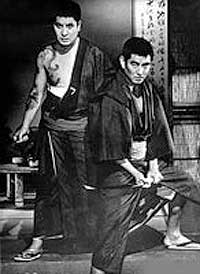 In the first episode of the long-running "Nippon Chivalry, Legends of the Yakuza series," Nihon kyoakuden (1964), Makino does manage to get more real facial expressions out of the dead-pan Ken Takakura than do most directors, & he gives Kiknnosuke Nakamura a chance to give a personal interpretation to the emotionally tortured gambler. In the first episode of the long-running "Nippon Chivalry, Legends of the Yakuza series," Nihon kyoakuden (1964), Makino does manage to get more real facial expressions out of the dead-pan Ken Takakura than do most directors, & he gives Kiknnosuke Nakamura a chance to give a personal interpretation to the emotionally tortured gambler.
Even though the film does not rise above the norm in either its photographic or acting worth, there is an undercurrent of negativity toward yakuza of all sorts, good as well as bad ones, refusing to play into the ninkyo or chivalrous gangster convention of a "good" yakuza being better than no yakuza at all. But what may at first appear to be moderately innovative is really only the effect of occurring at the start yakuza fad before the cliches were fully solidified.
Before the climactic battles roll round, we have a clear message that there is no such thing as a good yakuza when the ultimate prize is twenty percent of every laborer's income. When Nakamura goes on the raid which is usually the culminating orgasm of a lot of slow foreplay, he doesn't do it with his shortsword alone, but takes a gun. And he not only fails miserably & dies tragically, he has proven that the standard climax of the yakuza film is a lie, & in reality one man can't do it alone.
The rest of the Masa gang, purported good guys, are disbanded by their young labor boss played by Takakura, who apologizes to the oyabun who died of old age earlier in the film. They seek restitution for the workers who've had their lumber carts burned, & they set out to destroy the evil Oki group.
This is not to reaffirm the status quo as in most ninkyo yakuza pictures, but to purge the village of all yakuza once & for all. And rather than the standard raid on the yakuza headquarters, the Masa labor gang searches through the town for the bad guys, & one by one the Masa group members die while taking the Oki group down with them, in various locations around town.
There is no one-against-all battle here, except the pre-climactic one in which Kinnosuke Nakamura's character failed so sadly. There are other reinterpretations of standard yakuza set-pieces, such as the cliche of the good gambler's best friend working for the bag gang. Usually the veritable "brother" of the first lead is tied to an evil boss who he must obey despite disagreeing with everything. But the encounter between brothers in Makino's film is nothing heroic, merely pitiful, two good men killing each other to prove nothing at all.
Though the often-great director puts in a lot of personal overlay to the film, it nevertheless comes across as Toei's standard assembly line productions. And even as a standard yakuza film, it doesn't present the most effective emotional situations.
If Makino's film were judged better than average, it is only because the average is piss-poor & Makino at his worst is still competent. But there are occasional moments of true greatness in the yakuza genre, alas not to be found in Nihon kykokakuden. Since the series overall is extremely varied, some of the films that followed were much better than the first.
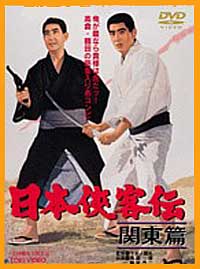 Market of Evil (Nihon kyokakuden: Kanto-hen, 1965) is set in Kanto in 1924. Ken Takakura proves to be quite good at comedy, playing a ship's mate befriending fish shop owners harrassed by yakuza, & it must be said that Masahiro Makino just about always got a good performance out of Ken, unlike Teruo Ishii who got very mixed-bag performances from him for the Abashiri Prison series.
Market of Evil (Nihon kyokakuden: Kanto-hen, 1965) is set in Kanto in 1924. Ken Takakura proves to be quite good at comedy, playing a ship's mate befriending fish shop owners harrassed by yakuza, & it must be said that Masahiro Makino just about always got a good performance out of Ken, unlike Teruo Ishii who got very mixed-bag performances from him for the Abashiri Prison series.
Koji Tsuruta co-stars, with Ken acting as jester to Koji's straight man. He loves the lady boss of the fish-sellers (Junko Fuji). As if these were stars enough to impress, Tetsuro Tamba also turns in a lovely performance as the scruffy sea captain who helps the fishmongers, circumventing yakuza interferences in order to provide fish. Minoru Oki plays the labor foreman.
Angst & suffering & attempts at forebearance will eventually result in a big action-climax. Ken & his fellow sailors riot against the yakuza while fish are unloaded for the fishmongers. Ken gets to do some of his signature katana swordplay action.
Meanwhile Koji attacks yakuza boss's house armed with knife & pistol. The fight choreography in both locations is believable but not the sort of stylish elegant fighting as one gets in similar climaxes when an actor like Ken Takakura fights mainly with katana.
It's rare that the primary good guy survives in the end, as each episode of this sort of nominal series is about different people even if played by many of the same actors, & sad endings are de rigour.
In this case, however, both Ken & Koji survive, & get haulted away together by the police. This would actually constitute a happy ending! And for a discussion of the subliminal "comrade love" of such characters, the importance of which outweighs by far any union with the leading lady, see the article on Subliminal & Overt Homoeroticism in Chivalrous Yakuza-eiga.
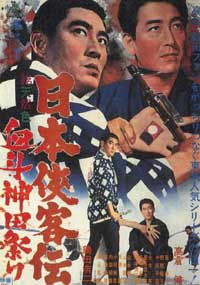 The Nippon Chivalry set of films are only nominally a "series" in that they all starred Ken Takakura playing one or another character with a sense of humanity & a capacity for violence, either a gambler or a member of a labor gang or an altogether different category of individual in conflict with yakuza. It was not a series about a single character. Just about any story could be told so long as its central character fit the ninkyo chivalrous category. The Nippon Chivalry set of films are only nominally a "series" in that they all starred Ken Takakura playing one or another character with a sense of humanity & a capacity for violence, either a gambler or a member of a labor gang or an altogether different category of individual in conflict with yakuza. It was not a series about a single character. Just about any story could be told so long as its central character fit the ninkyo chivalrous category.
In the fourth film of the set, Nihon kyokaku-den: ketto kanda matsuri (Festival of Duels, 1966), Ken plays a fireman at a time when the old-style Edo firemen were being replaced by modern firefighters with fire engines.
Traditional firemen were tattooed toughs who would not put out fires so much as tear down buildings around a fire to create fire breaks & let the fires burn themselves out without spreading for blocks around. It was dangerous close-in work of flames & demolition & firemen were frequently well known heros, were even the subject of "heroic firemen" block prints.
Ken's character helps a shopkeeper against yakuza who want his property. The firemen also have to save the shop's mistress (Junko Fuji). Ken goes in the raid with a fireman's hook & puts on a great fight against longswords.
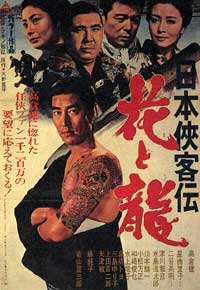 Co-star Koji Tsuruta, a chivalrous gambler, is a wanted man & is staying with the bad guys while laying low. He dies during the heroic raid with longsword. We are left with the clear message that there may be a price to pay, but even so, violence is what it takes to save the world. Co-star Koji Tsuruta, a chivalrous gambler, is a wanted man & is staying with the bad guys while laying low. He dies during the heroic raid with longsword. We are left with the clear message that there may be a price to pay, but even so, violence is what it takes to save the world.
In all, Makino directed nine Nihon kyokaku-den episodes, the first half dozen helping to define Toei's product for the rest of the decade. When Makino was done with the series, two more episodes were added, directed by Kosaku Yamashita & Shigehiro Ozawa respectively for episodes 10 & 11.
Ken Takakura held the set together as a series even as place & character changed. Guest stars for sundry episodes tended to be the "other" chivalrous gambler players, including Koji Tsuruta, Kotaro Okochi, & Ryo Ikebe. Makino's ninth & last episode was his best, Nihon kyokaku-den: Hana to Ryu (The Flower & the Dragon, 1969) pairing Takakura with his most thrilling leading lady, Junko Fuji, & bringing in Tomisaburo Wakayama for good measure.
Here is the entire Nihon kyokaku-den Nippon Chivalry "Legends of the Yakuza" series in order of their release:
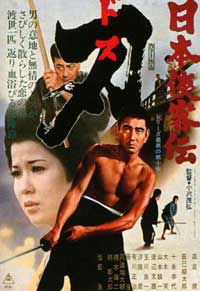 1. Nihon kyokaku-den. (1964)
1. Nihon kyokaku-den. (1964)
2. Nihon kyokakuk-den: Naniwa-hen. (1965)
3. Nihon kyokakuk-den: Kanto-hen. (1965)
4. Nihon kyokakuk-den: Ketto Kanda-matsuri. (1966)
5. Nihon kyokakuk-den: Kaminari-mon no Ketto. (1966)
6. Nihon kyokakuk-den: Shiraha no Sakazuki. (1967)
7. Nihon kyokaku-den: Kirikomi. (1967)
8. Nihon kyokaku-den: Zetsuen-jo. (1968)
9. Nihon kyokaku-den: Hana to Ryu. (1969)
10. Nihon kyokaku-den: Nobori-ryu. (1970)
11. Nihon kyokaku-den: Dosu. (1971)
copyright © by Paghat the Ratgirl
|
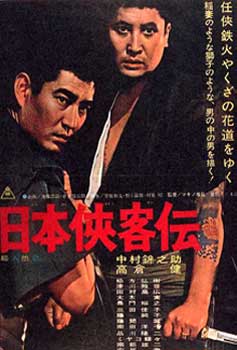
 In the first episode of the long-running "Nippon Chivalry, Legends of the Yakuza series," Nihon kyoakuden (1964), Makino does manage to get more real facial expressions out of the dead-pan Ken Takakura than do most directors, & he gives Kiknnosuke Nakamura a chance to give a personal interpretation to the emotionally tortured gambler.
In the first episode of the long-running "Nippon Chivalry, Legends of the Yakuza series," Nihon kyoakuden (1964), Makino does manage to get more real facial expressions out of the dead-pan Ken Takakura than do most directors, & he gives Kiknnosuke Nakamura a chance to give a personal interpretation to the emotionally tortured gambler.

 Co-star Koji Tsuruta, a chivalrous gambler, is a wanted man & is staying with the bad guys while laying low. He dies during the heroic raid with longsword. We are left with the clear message that there may be a price to pay, but even so, violence is what it takes to save the world.
Co-star Koji Tsuruta, a chivalrous gambler, is a wanted man & is staying with the bad guys while laying low. He dies during the heroic raid with longsword. We are left with the clear message that there may be a price to pay, but even so, violence is what it takes to save the world. 1. Nihon kyokaku-den. (1964)
1. Nihon kyokaku-den. (1964)